What Flower Symbolizes New Beginnings? Daffodil!
The daffodil, or Narcissus, symbolizes rebirth and new beginnings. This flower’s vibrant yellow blooms mark the end of winter, embodying resilience across diverse climates.
Its appearance reminds us of nature’s cyclical patterns, making it a meaningful symbol of hope and encouragement.
Daffodils thrive in various environments, showcasing their adaptability and the universal appeal of renewal.
As they pierce through the last of winter’s chill, they represent the indomitable spirit of rejuvenation.
If you’re intrigued by the symbolism behind flowers, the daffodil’s story of resilience and renewal offers a deeper glimpse into nature’s profound cycles of life.
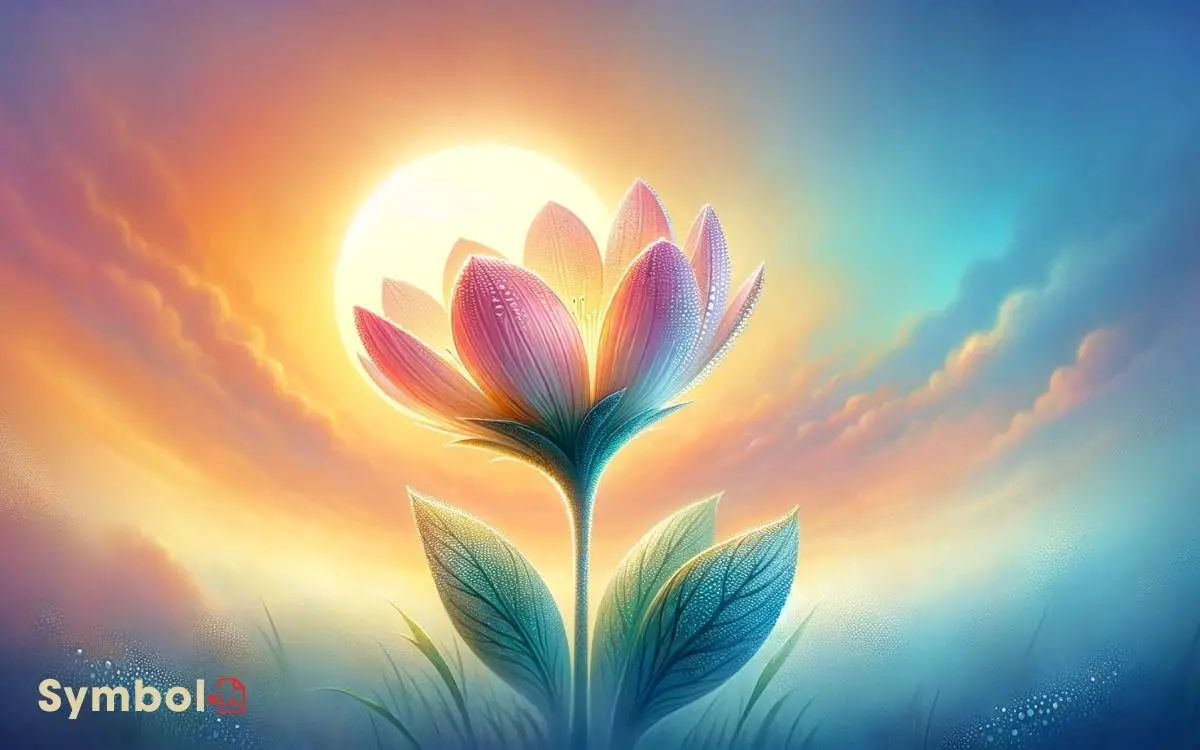
Key Takeaways
10 Flowers That Symbolize New Beginnings
| Flower | Symbolism | Color Varieties | Common Occasions |
|---|---|---|---|
| Daffodil | New beginnings | Yellow, White, Orange | Spring celebrations, New jobs |
| Lotus | Rebirth, Purity | Pink, White, Blue, Purple | Spiritual events |
| Cherry Blossom | Renewal, Hope | Pink, White | Spring festivals |
| White Lily | Purity, Rebirth | White | Weddings, Easter |
| Crocus | Youthfulness | Purple, White, Yellow | Spring events, Graduations |
| White Rose | New starts | White | Weddings, Memorials |
| Dahlia | Change, Kindness | Varies widely | Various celebrations |
| Calla Lily | New beginnings | White, Pink, Yellow, Purple | Weddings, Anniversaries |
| Forsythia | Anticipation | Yellow | Various springtime events |
| Alstroemeria | Aspiring | Many colors including pink, red, yellow, purple | Friendships, Encouragement |
The Daffodil: Renewals Herald

The daffodil, known scientifically as Narcissus, symbolizes rebirth and new beginnings, making it an emblematic herald of renewal.
Emerging in early spring, its vibrant yellow blooms are among the first to announce the end of winter’s dormancy, offering a bright prelude to the season’s unfolding.
This perennial flower, belonging to the Amaryllidaceae family, exhibits not only remarkable resilience but also an ability to thrive in varied climates, mirroring the adaptability required for personal growth and transformation.
Its presence in gardens and wild landscapes alike serves as a reminder of nature’s cyclical patterns and the perpetual opportunity for renewal.
Cultivating or gifting daffodils can be a meaningful gesture, symbolizing hope and encouragement as you or a loved one starts on new endeavors.
Cherry Blossoms: Fleeting Beginnings
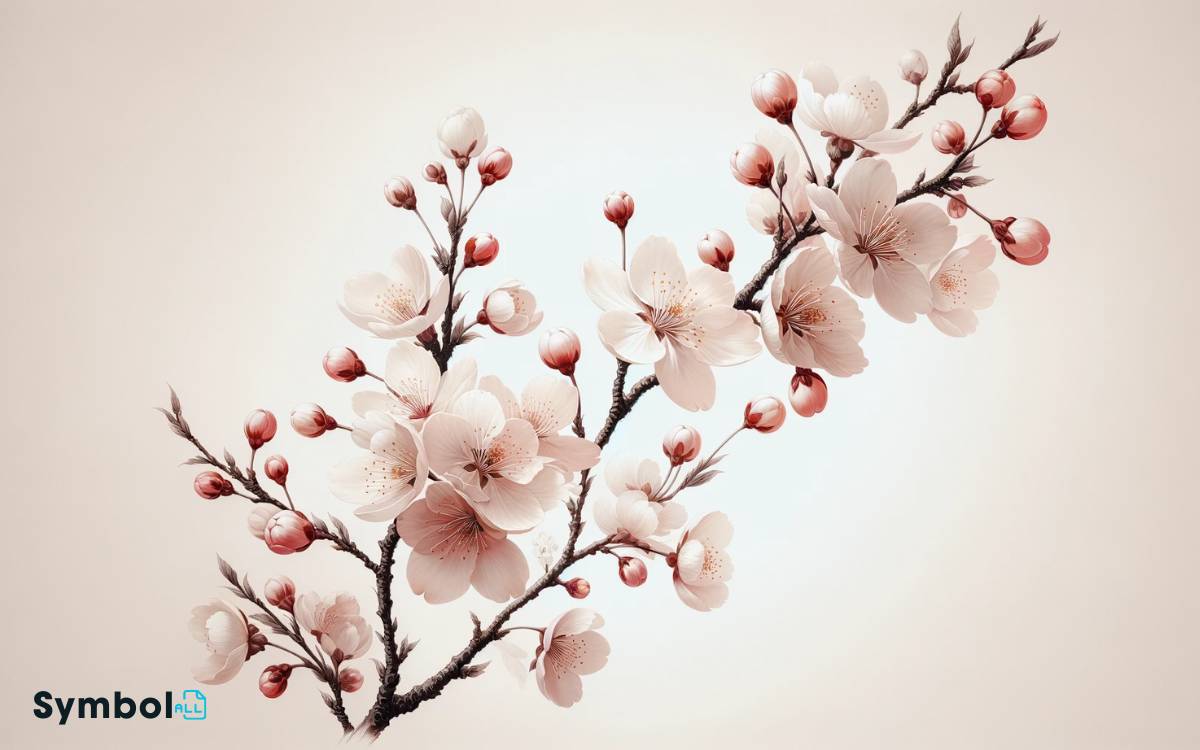
You’ll find that cherry blossoms, with their brief blossoming period, epitomize the essence of transient beauty in nature, symbolizing new beginnings that are both swift and momentous.
Their fleeting presence is a poignant reminder of life’s ephemeral nature, encouraging observers to cherish each moment.
This symbolic significance has deep roots in various cultures, where cherry blossoms are celebrated for their delicate balance between fragility and renewal.
Symbolic Significance
Cherry blossoms serve as a poignant symbol of new beginnings, embodying the ephemeral nature of life with their brief yet breathtaking bloom.
These flowers, scientifically known as Prunus serrulata, are deeply ingrained in cultural narratives, representing not only the fleeting beauty of existence but also the fragility and constant renewal inherent in the cycle of life.
In many traditions, they’re associated with the resilience and rebirth that follows a period of hardship or change, making them a powerful emblem for those starting on new journeys or phases.
Their delicate appearance belies a profound message: life’s most beautiful moments are often transient, urging you to embrace change and renewal with openness and optimism.
Brief Blossoming Period
Considering the symbolic significance of cherry blossoms, their beauty is heightened by their brief blossoming period, usually lasting from one to two weeks.
This ephemeral nature underscores a powerful message about the fleeting nature of life, making them a poignant symbol for new beginnings.
The blossoms’ lifecycle starts with a rapid burst of growth, where buds swell and bloom almost overnight.
This rapid transformation is a marvel of nature, driven by a combination of genetic programming and environmental factors such as temperature and sunlight.
The peak bloom, when the trees are fully flowered, creates a breathtaking canopy of delicate pink and white.
However, this peak is short-lived. Within days, the blossoms begin to fall, covering the ground in a carpet of petals, reminding you to cherish each moment.
White Lilies: Purity and Rebirth
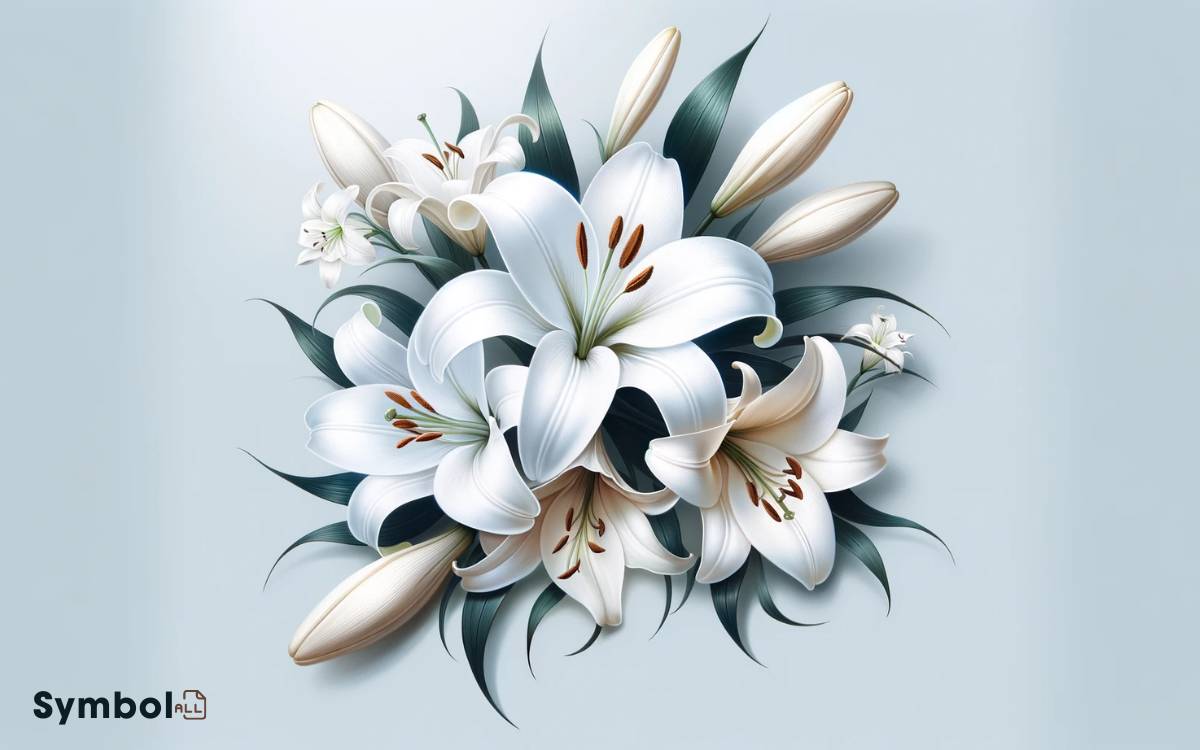
White lilies symbolize purity and rebirth, embodying a shift towards fresh starts with their pristine and elegant blooms.
These flowers aren’t just visually striking; their symbolism is deeply rooted in cultural and scientific significance.
The white lily, or Lilium candidum, thrives in diverse environments, adapting to signify resilience and transformation.
| Aspect | Scientific Insight | Symbolic Meaning |
|---|---|---|
| Color | Absence of pigment, purity | Innocence, New beginnings |
| Growth | Perennial, rebirth annually | Renewal, Continuity |
| Bloom | Large, prominent flowers | Visibility, Significance |
Understanding the white lily’s lifecycle and characteristics offers a nuanced appreciation for its role as a symbol of new starts. Its adaptability and striking presence speak volumes, making it a powerful emblem for those starting on new journeys.
Lotus Flower: Emerging Unscathed

Rising from murky waters, the lotus flower represents an unparalleled symbol of purity and enlightenment, untouched by the mire below.
This remarkable plant, belonging to the Nelumbo genus, thrives in muddy rivers and ponds, yet emerges with leaves and blossoms remarkably clean.
This phenomenon, known scientifically as the lotus effect, occurs due to the flower’s uniquely structured leaves, which are highly hydrophobic, repelling water and particles of dirt.
This natural cleaning mechanism symbolizes spiritual awakening and the ability to rise above challenges unscathed.
In various cultures, the lotus is revered as a symbol of rebirth, its daily re-emergence from the water reflecting the idea of resurrection and the eternal cycle of life, making it an ideal emblem for new beginnings.
The Daisy: Innocence and Newness
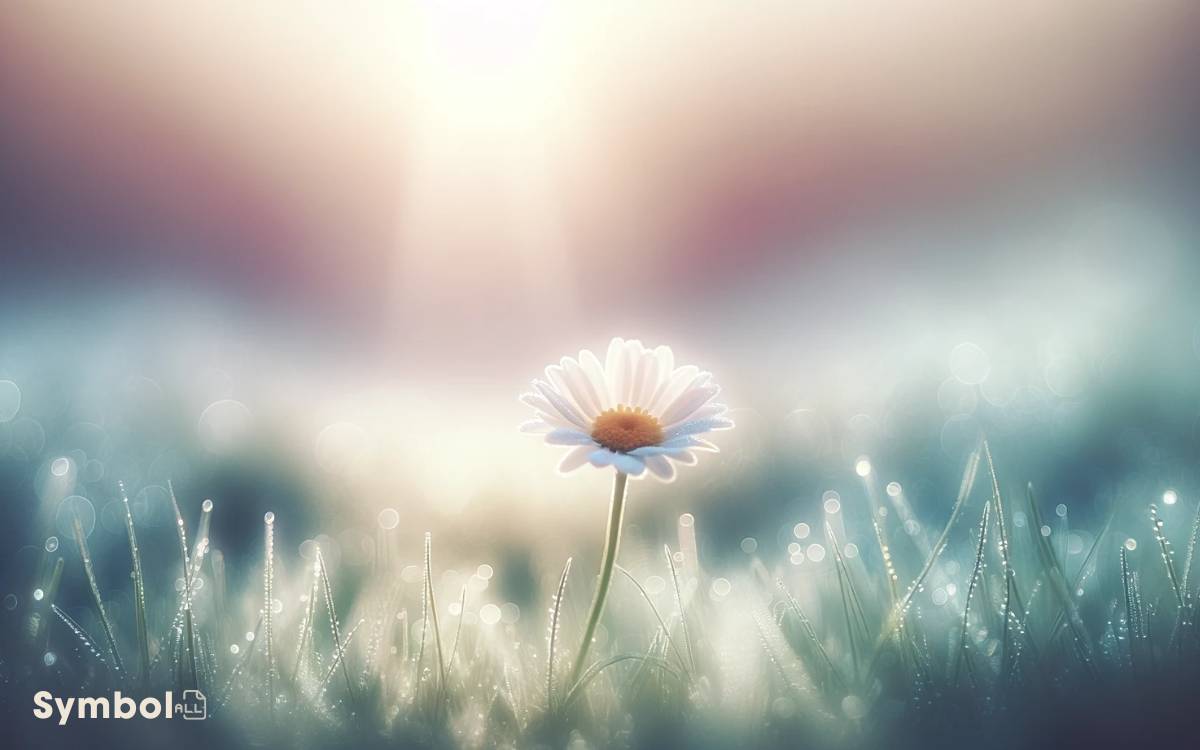
You’ll find that the daisy, with its simple yet striking appearance, embodies innocence and the freshness of new beginnings. Its symbolic meanings are deeply rooted in various cultures, reflecting purity, true love, and newness.
Additionally, understanding its gardening requirements can enhance its growth and symbolic presence in your life.
Daisys Symbolic Meanings
Daisies symbolize innocence and new beginnings, embodying purity with their bright, unblemished petals that seem to emerge fresh from the earth. This isn’t merely poetic imagery; it’s grounded in the daisy’s botanical characteristics and life cycle.
Their perennial nature allows them to return year after year, each time as if they’re gracing the world anew. This cyclical rebirth mirrors the human experience of renewal and hope.
Additionally, the structure of a daisy, with its composite flower head consisting of tightly packed florets surrounded by long, radiant rays, serves as a metaphor for unity and collective growth.
Each petal contributes to the whole, suggesting that beginnings, though seemingly singular, are part of a larger, interconnected tapestry of life.
Cultural Significance
Beyond their botanical symbolism, daisies hold deep cultural significance, embodying themes of innocence and newness across various societies.
In Norse mythology, the daisy is associated with Freya, the goddess of love, beauty, and fertility, symbolizing childbirth and motherhood. This association underscores the flower’s embodiment of new beginnings and purity.
In medieval times, daisies were often featured in art and literature, representing simplicity and untouched beauty.
They were symbols of the Virgin Mary’s innocence in Christian iconography, further cementing their association with purity and new life.
Across cultures, the daisy’s unassuming appearance belies its profound symbolism, making it a universally revered symbol of fresh starts and innocence.
This cultural tapestry enriches the daisy’s simple beauty, offering layers of meaning for those who seek understanding.
Gardening Tips
To cultivate daisies, reflecting their symbolism of innocence and newness, comprehending their specific horticultural needs is essential, beginning with soil composition and sun exposure.
Daisies thrive in well-drained soil rich in organic matter. You’ll find they prefer a pH between 6.0 and 8.0, so testing your soil before planting is wise.
Equally important is ensuring they receive at least 6 hours of sunlight daily; however, in hotter climates, some afternoon shade benefits them greatly.
Watering demands balance; overwatering can lead to root rot, while under-watering stresses the plant. Aim for moist, not waterlogged, soil. Fertilization should be moderate, using a balanced, slow-release fertilizer in the spring.
Lastly, deadheading spent flowers encourages continuous blooming, embodying the concept of new beginnings throughout the season.
Crocus: First Signs of Spring
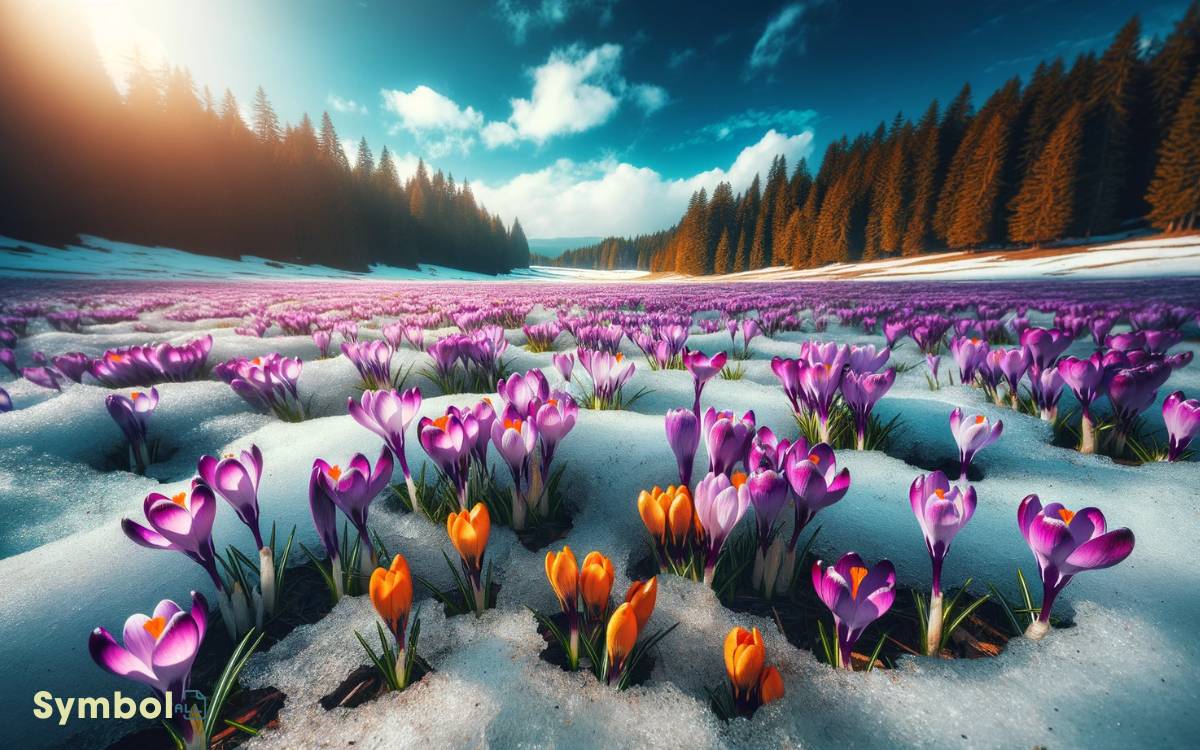
As the snow melts and the earth reawakens, crocuses emerge as harbingers of spring, symbolizing new beginnings with their vibrant hues. These early bloomers aren’t just a feast for the eyes; they’re a beacon of the seasonal change.
Here’s what makes them special:
- Adaptation: Crocuses have evolved to push through the thawing soil, signaling resilience and hope.
- Variety: With over 80 species, their colors range from deep purples to bright yellows, representing diversity and richness.
- Pollination: They’re among the first food sources for bees, underscoring the interconnectedness of life.
- Growth: Crocuses thrive in cold climates, reminding us that growth often follows the harshest conditions.
Their emergence teaches you to embrace change and appreciate the fleeting beauty of beginnings.
Tulips: Love and Fresh Starts
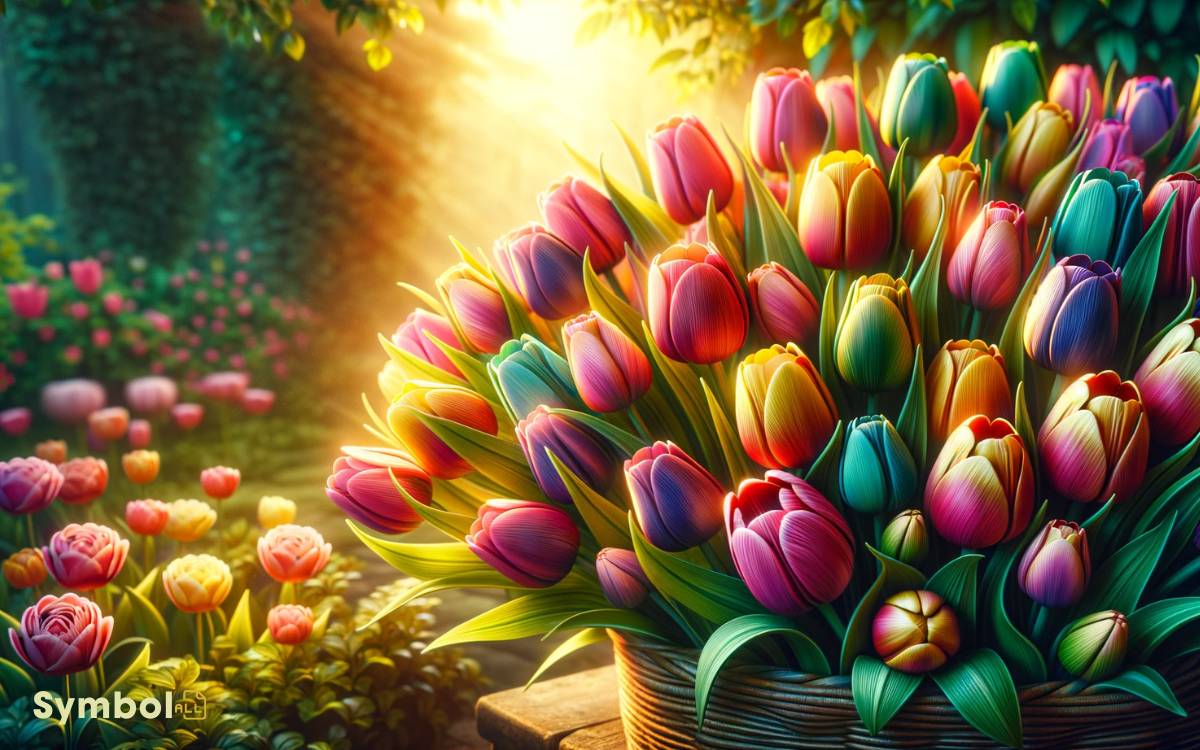
With their vibrant petals unfolding from the soil, tulips symbolize love and the promise of new beginnings, embodying the rejuvenation that accompanies the transition from winter to spring.
Originating from the mountainous regions of Central Asia, they’ve adapted to a variety of climates, showcasing their resilience and versatility. This flexibility mirrors the human capacity for growth and renewal.
Tulips’ genetic diversity has led to a plethora of colors and shapes, each variety carrying its own unique symbolism.
For instance, red tulips are often associated with true love, while purple signifies royalty and white conveys forgiveness.
This rich palette allows tulips to express a wide range of emotions related to fresh starts, making them a perfect symbol for those initiating new ventures or relationships.
Sunflowers: Bright Futures
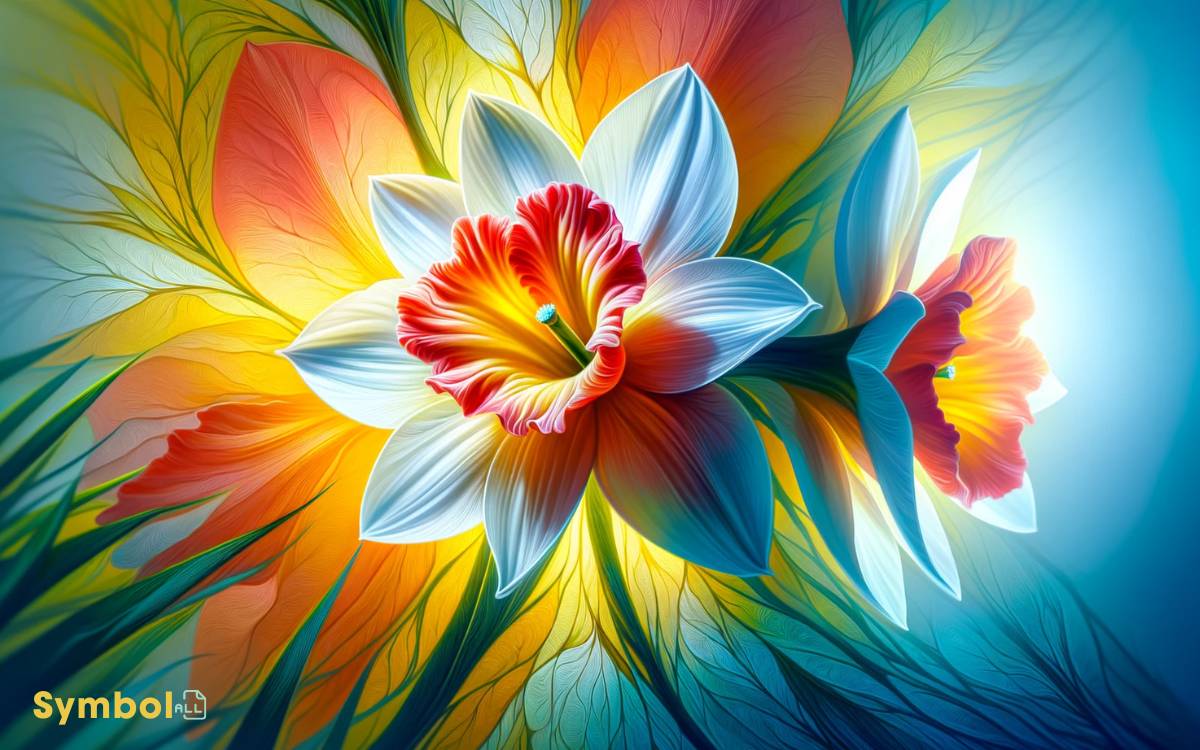
You’ll find sunflowers harness sunlight in a unique process known as heliotropism, optimizing their growth cycle by facing the sun throughout the day.
This behavior not only maximizes their energy absorption for more robust growth but also embeds them with symbolic meanings of optimism and longevity.
Understanding these aspects offers insights into why sunflowers stand as powerful symbols for bright futures and new beginnings.
Sunlights Role
Sunflowers, embodying bright futures, thrive under the sun’s nurturing rays, demonstrating nature’s intricate reliance on sunlight for growth and renewal.
You’ll find these bright blooms turning their heads to follow the sun’s path across the sky a phenomenon known as heliotropism.
This dance with the sunlight isn’t just for show; it’s a critical part of their life cycle, guaranteeing they receive the energy needed for photosynthesis.
- Photosynthesis Activation: Sunlight triggers chlorophyll production, converting light into chemical energy.
- Growth Stimulation: Sun exposure stimulates stem elongation, propelling the sunflower to reach toward the light.
- Bud Formation: Adequate sunlight guarantees the development of vibrant, yellow petals.
- Seed Maturation: Sunlight assists in the ripening of seeds, ensuring the cycle of life continues.
Understanding this reliance highlights the sunflower’s symbolic representation of new beginnings and the importance of sunlight in nurturing growth.
Growth Cycle
Building on the understanding of sunlight’s role in sunflower development, let’s explore the growth cycle of these symbols of bright futures, from seedling to full bloom.
Initially, a sunflower begins as a seed planted in nutrient-rich soil, requiring ample sunlight and water to germinate.
Within 7-10 days, the seedling emerges, displaying its first set of true leaves. This phase is pivotal for photosynthesis, fueling rapid growth.
Sunflowers are known for their heliotropism; young plants tilt during the day to face the sun, maximizing light absorption. As the stem strengthens, this movement ceases.
The shift from vegetative to reproductive stage marks the budding phase, culminating in the iconic yellow bloom. This entire cycle, from seed to flower, spans approximately 80-120 days, depending on the variety and environmental conditions.
Symbolic Meanings
Embodying a tapestry of hope and renewal, sunflowers symbolize bright futures with their radiant blooms turning toward the sun. These vibrant flowers aren’t just aesthetically pleasing; they’re packed with meaning and significance.
Let’s explore the imagery they evoke:
- Heliotropism: Sunflowers exhibit a unique behavior known as heliotropism, where they turn their heads to follow the sun across the sky. This mirrors the idea of always seeking the light or positivity in life, despite the darkness.
- Vibrant Yellow Petals: Their bright yellow hue symbolizes happiness and vitality, suggesting a future filled with joy.
- Sturdy Stems: The robust stems of sunflowers stand tall and strong, representing resilience and the ability to withstand challenges.
- Seeds of Potential: The center of a sunflower, brimming with seeds, signifies potential for growth and abundance in the journey ahead.
Peonies: Prosperity and Honor
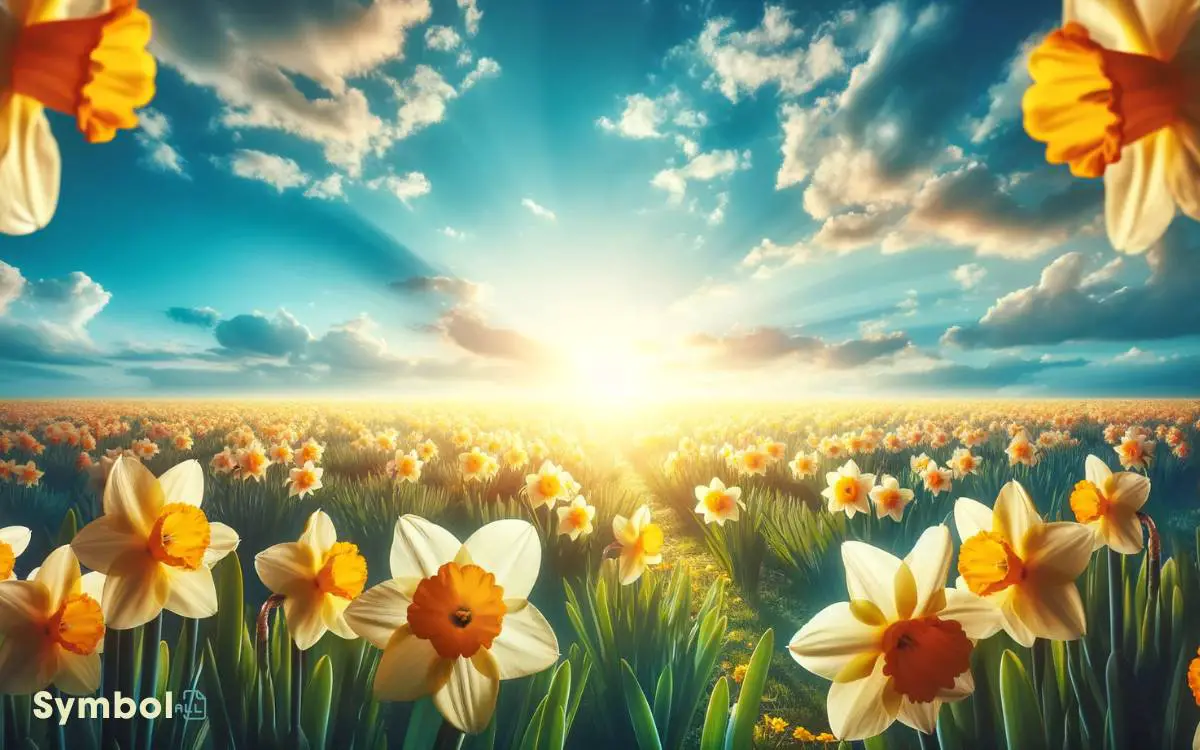
Peonies, symbolizing prosperity and honor, have long been revered in various cultures for their lush blooms and rich history.
Originating from Asia, these perennials belong to the genus Paeonia and thrive in temperate regions.
Their cultivation dates back over a thousand years, especially in China where they’re considered the ‘king of flowers‘ and embody wealth and high status.
Scientifically, peonies exhibit a fascinating growth pattern, evolving from tight spherical buds to expansive, aromatic blooms.
This transformation has made them a metaphor for flourishing in adversity, embodying the potential for personal and professional growth.
Additionally, the variety of colors, from pure white to deep red, enhances their symbolism, with each hue representing different facets of prosperity and honor.
Hyacinth: Constancy and Renewal
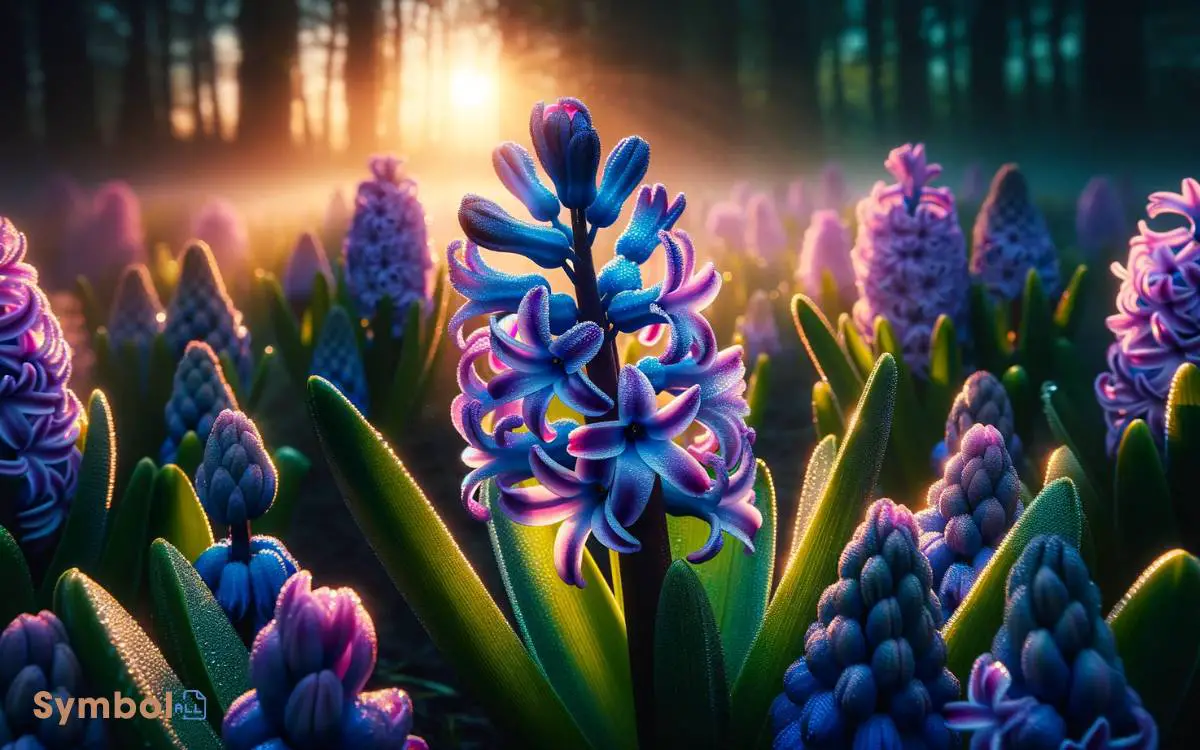
Moving from the lush peonies, let’s explore the hyacinth, a flower symbolizing constancy and renewal with its vibrant blooms and enduring fragrance.
The hyacinth stands out for its unique qualities:
- Dense Flower Spikes: The hyacinth produces dense, star-shaped flowers along tall, erect spikes, contributing to its striking appearance.
- Variety of Colors: Ranging from soft pastels to vivid hues, hyacinths can be found in white, blue, purple, and pink, each color adding a different layer of meaning.
- Fragrance: Known for its powerful, sweet scent, the hyacinth’s fragrance is often associated with the freshness of spring.
- Growth Cycle: Hyacinths bloom in early spring, symbolizing rebirth and the rejuvenation of nature.
This flower’s enduring nature and ability to return year after year make it a poignant symbol for constancy and the promise of new beginnings.
Narcissus: Self-Reflection and New Beginnings
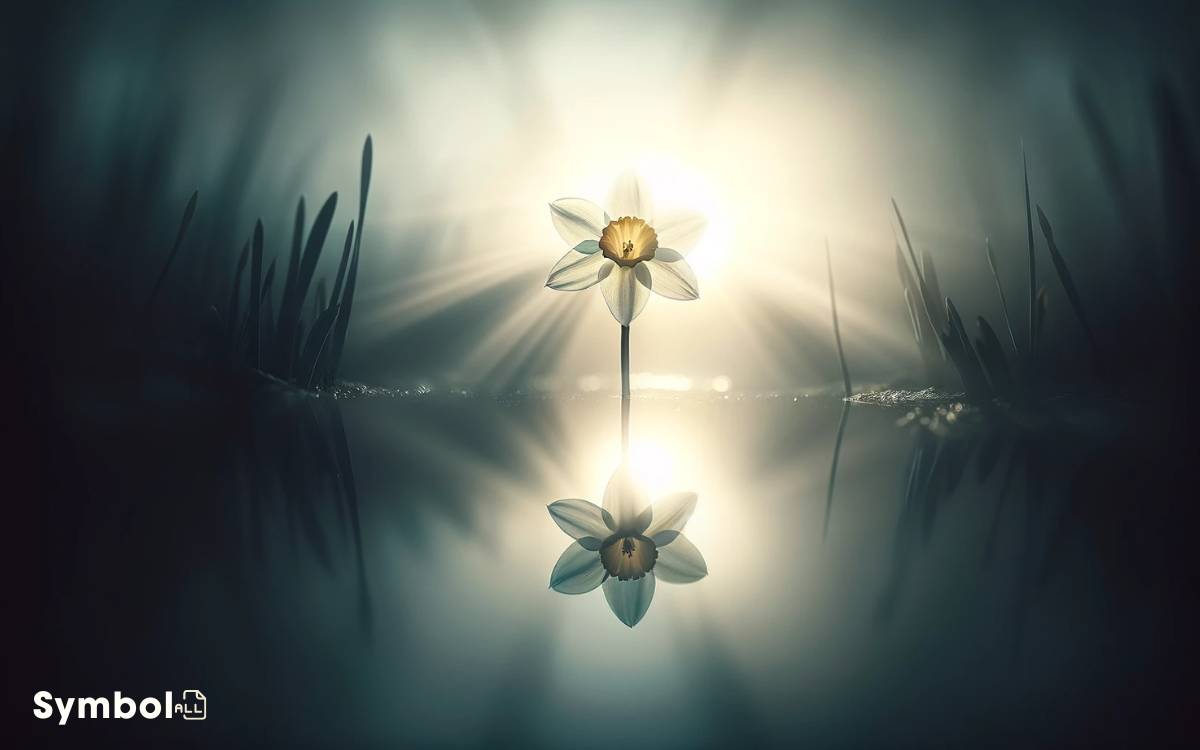
You’ll find the Narcissus flower embodies themes of self-reflection and renewal across various cultures, with its symbolism deeply rooted in ancient mythology and traditions.
Its widespread cultural significance highlights its role in celebrations and rituals, marking it as a universal symbol of new beginnings.
Understanding its blooming season offers further insight into its role as a herald of spring, symbolizing rebirth and new opportunities.
Narcissus Symbolism Explained
In the realm of symbolic flora, the Narcissus stands out as a beacon of self-reflection and heralds the arrival of fresh starts.
This flower’s symbolism is deeply rooted in its botanical characteristics and lifecycle, offering you a rich tapestry of metaphors for personal growth and renewal.
- The Narcissus’s bulbous nature: Symbolizing the dormant potential within, ready to emerge with the right circumstances.
- Its resilient spring bloom: Represents conquering the darkness of winter, a metaphor for personal hurdles.
- The bright, forward-facing flowers: Signify focusing on the future rather than lingering in the past.
- The plant’s reflection-inducing pools of water: Encourages self-examination and introspection, fundamental for any fresh start.
Understanding the Narcissus in this detailed, scientific manner reveals its profound ability to inspire and guide through life’s changes.
Cultural Significance Worldwide
The cultural significance of the Narcissus spans continents, embodying themes of self-reflection and new beginnings in various traditions worldwide.
In Eastern cultures, particularly in China, the Narcissus is celebrated during the Lunar New Year as a symbol of prosperity and rejuvenation.
Its ability to bloom from bulbs submerged in water without soil is seen as a confirmation of purity and resilience, ushering in a period of renewal and growth.
Meanwhile, in Western mythology, the Narcissus is associated with the Greek tale of Narcissus, a youth who fell in love with his own reflection.
This story has imbued the flower with meanings of self-awareness and the importance of recognizing one’s worth, often interpreted as a reminder of the value of introspection for personal development and renewal.
Blooming Season Insights
Understanding the blooming season of the Narcissus offers insights into its symbolic representation of self-reflection and new beginnings. This period is a demonstration of the cycles of renewal and introspection that define human experiences.
- Late Winter Emergence: As the first green shoots push through the frosty ground, they symbolize hope and the promise of renewal.
- Early Spring Bloom: The flowers’ peak in early spring signifies the awakening of self-awareness after a period of introspection.
- Bright Yellow Hues: Their radiant color mirrors the sun’s warmth, encouraging us to embrace change and growth.
- Lifecycle Completion: By late spring, as the blooms fade, they remind us of the impermanence of stages in life, urging us to reflect and prepare for new beginnings.
Primrose: Early Optimism
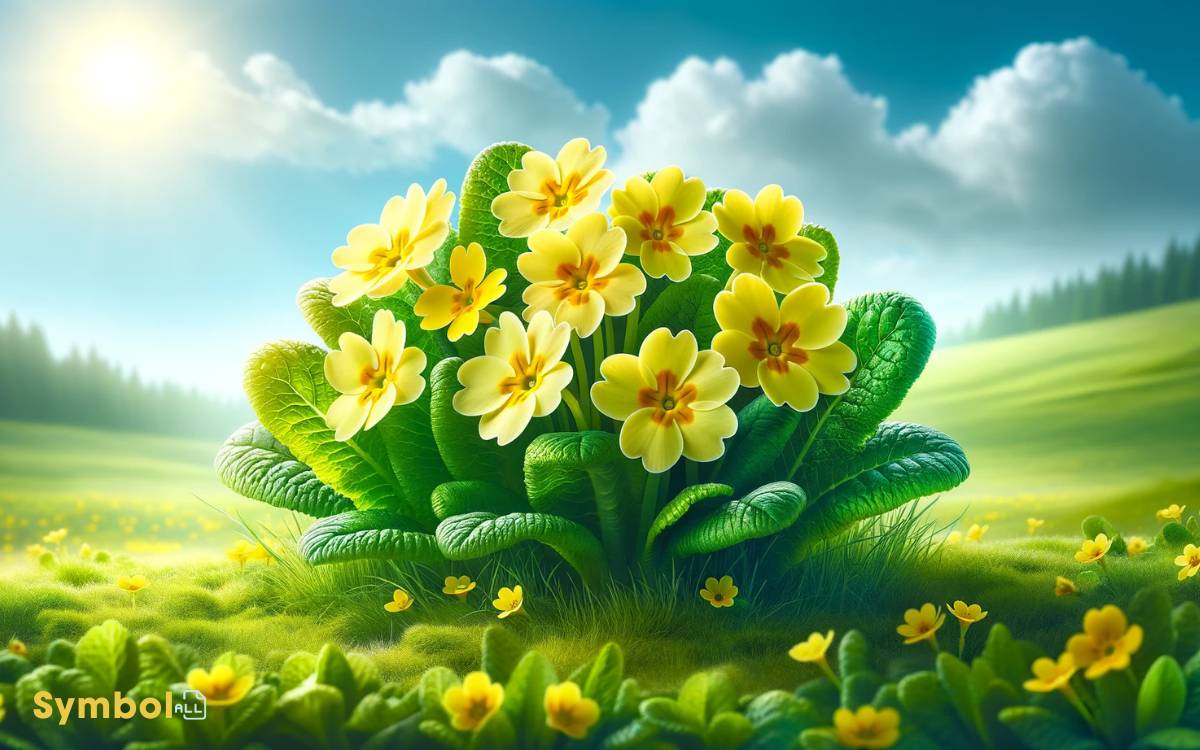
Primrose’s early bloom symbolizes a beacon of hope and renewal, embodying the essence of optimism as nature awakens from its winter slumber. Thriving in the cool, early days of spring, the primrose is among the first to herald the upcoming abundance of the season.
Its varied hues, from vivid yellows to soft pinks, mirror the diversity and resilience found in new beginnings.
Scientifically known as Primula, this genus encompasses over 500 species, each adapted to a range of climates, demonstrating nature’s incredible adaptability.
You’ll find primroses illuminating woodland areas and garden borders, their presence a reminder that perseverance through darker times leads to renewal.
Cultivating primroses in your own space can symbolize your readiness for and openness to change, embracing each new chapter life presents.
Forget-Me-Nots: True Love and Memories
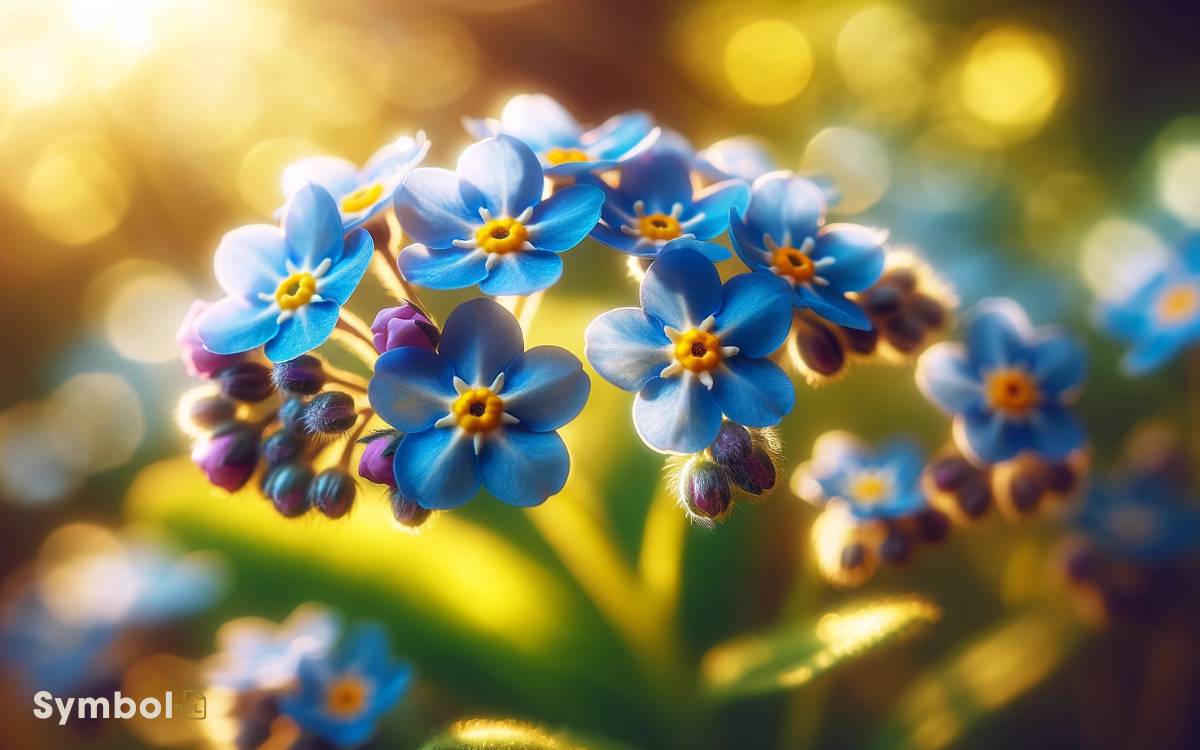
Embodying the essence of enduring love and the persistence of memory, Forget-Me-Nots, scientifically known as Myosotis, bloom as vivid reminders of connections that withstand the test of time.
These small yet striking flowers carry deep symbolic meaning, resonating with those who value the lasting nature of true love and the importance of cherishing memories.
To paint a picture in your mind, consider:
- The delicate blue petals, representing fidelity and trust.
- The bright yellow center, symbolizing the light of remembrance.
- The lush green foliage, embodying hope and renewal.
- The way they interlace in wildflower meadows, illustrating interconnectedness and support.
Forget-Me-Nots serve as a botanical declaration to the strength of emotional bonds, urging you to hold dear the memories and love that shape your journey.
Azaleas: Taking Care of Yourself
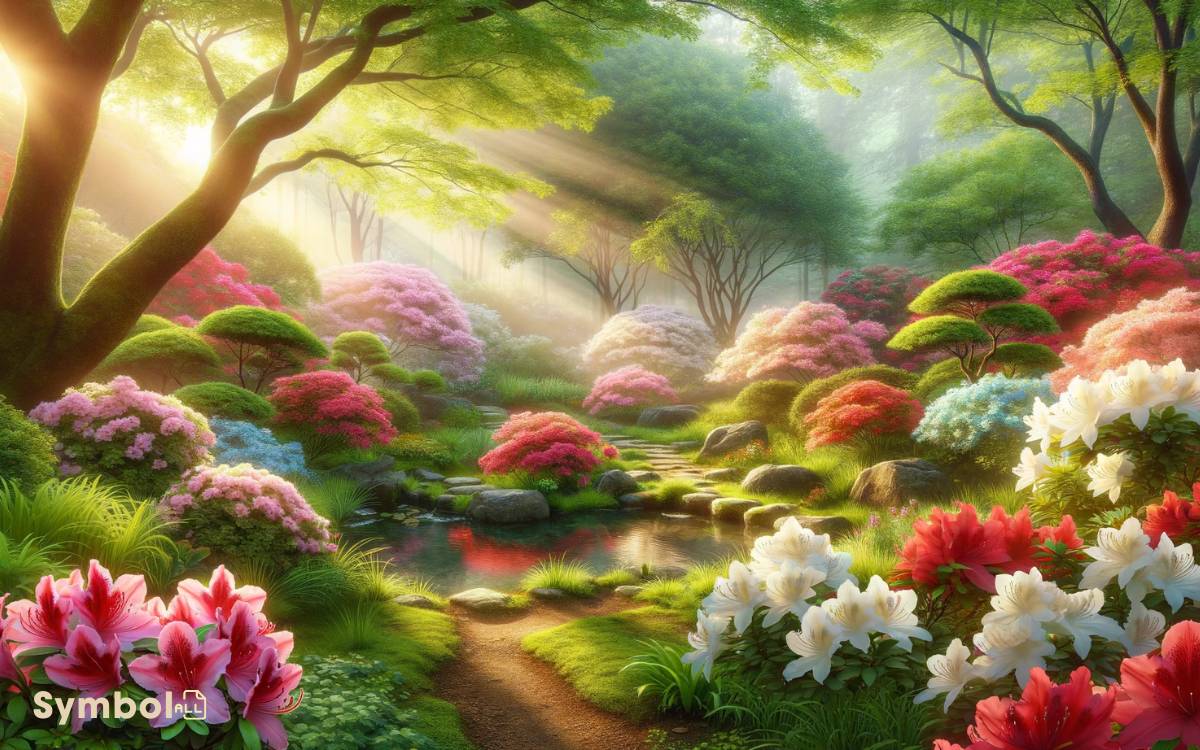
In the domain of symbolic flora, Azaleas stand out as beacons of self-care and personal well-being, urging you to nurture your inner garden with the same attentiveness you’d give these vibrant blossoms.
Azaleas, with their diversity of colors and resilience, symbolize the importance of taking care of yourself, both physically and emotionally. To thrive, they require specific conditions, mirroring the nuanced needs of human well-being.
| Factor | Recommendation |
|---|---|
| Soil pH | Slightly acidic, 5.5-6.0 |
| Sunlight | Partial shade preferred |
| Watering | Keep soil consistently moist |
Just as Azaleas flourish with the right care, focusing on your needs and well-being leads to a vibrant and fulfilling life.
Violets: Modesty and Fresh Starts
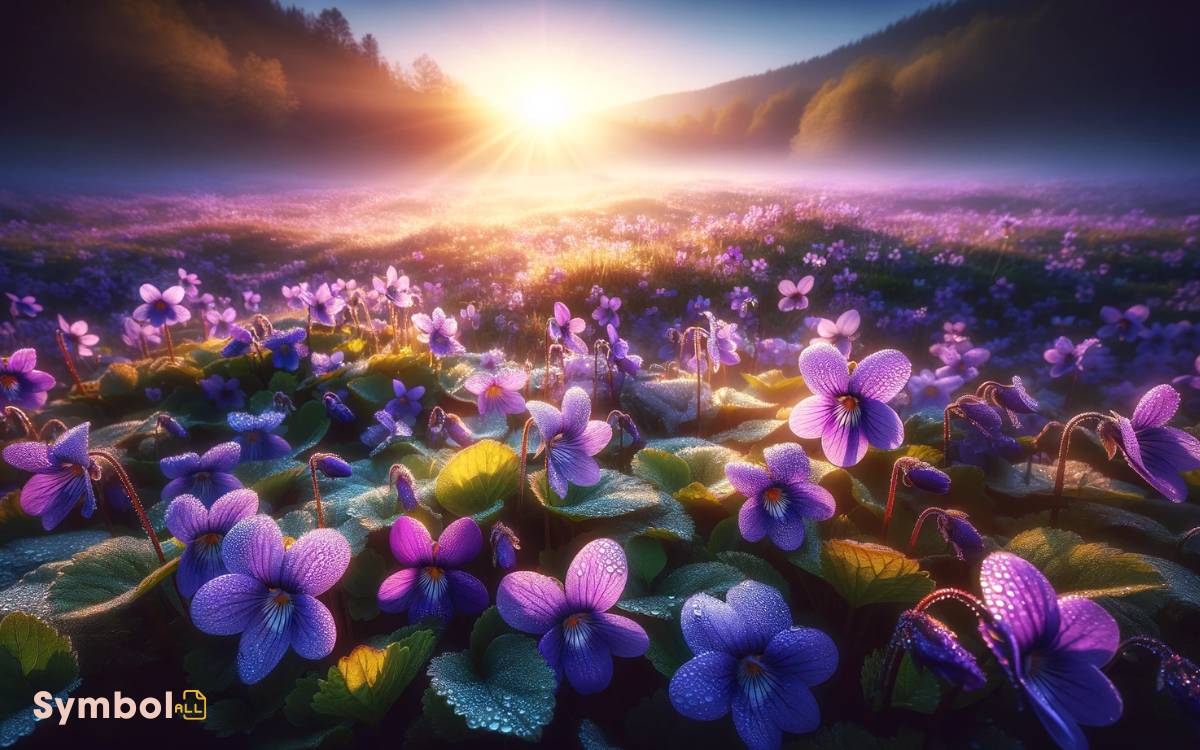
Violets, with their delicate blossoms and rich symbolism, offer a gentle reminder of the virtues of modesty and the promise of new beginnings. These flowers embody resilience and growth, characteristics essential for fresh starts.
When you observe violets, consider:
- The vibrant hue that ranges from deep purples to soft blues, symbolizing the depth and complexity of transformation.
- The heart-shaped leaves that represent love and affection, grounding you in the support necessary for new ventures.
- Their ability to thrive in hidden places, illustrating that growth often occurs in the most unexpected areas of our lives.
- The fleeting nature of their bloom, reminding us that beginnings, though brief, are profoundly impactful.
Understanding violets in this detailed, scientific manner enriches your appreciation for their role in symbolizing new beginnings.
Conclusion
As you stand at life’s crossroads, remember, each flower in nature’s vast garden whispers secrets of renewal and hope.
Like the resilient daffodil breaking through thawing soil, or the cherry blossom’s fleeting beauty reminding us of the ephemeral nature of beginnings, these botanical wonders embody the essence of starting anew.
So, when you’re ready to turn the page, let the purity of white lilies, the unscathed emergence of the lotus, and the optimistic bloom of the primrose guide your path.
Embrace your journey with the innocence of a daisy, the enduring love of forget-me-nots, the self-care symbolized by azaleas, and the modesty and fresh starts violets propose.
Nature’s blooms are your allies, illuminating your path to new beginnings with their silent, enduring wisdom.






